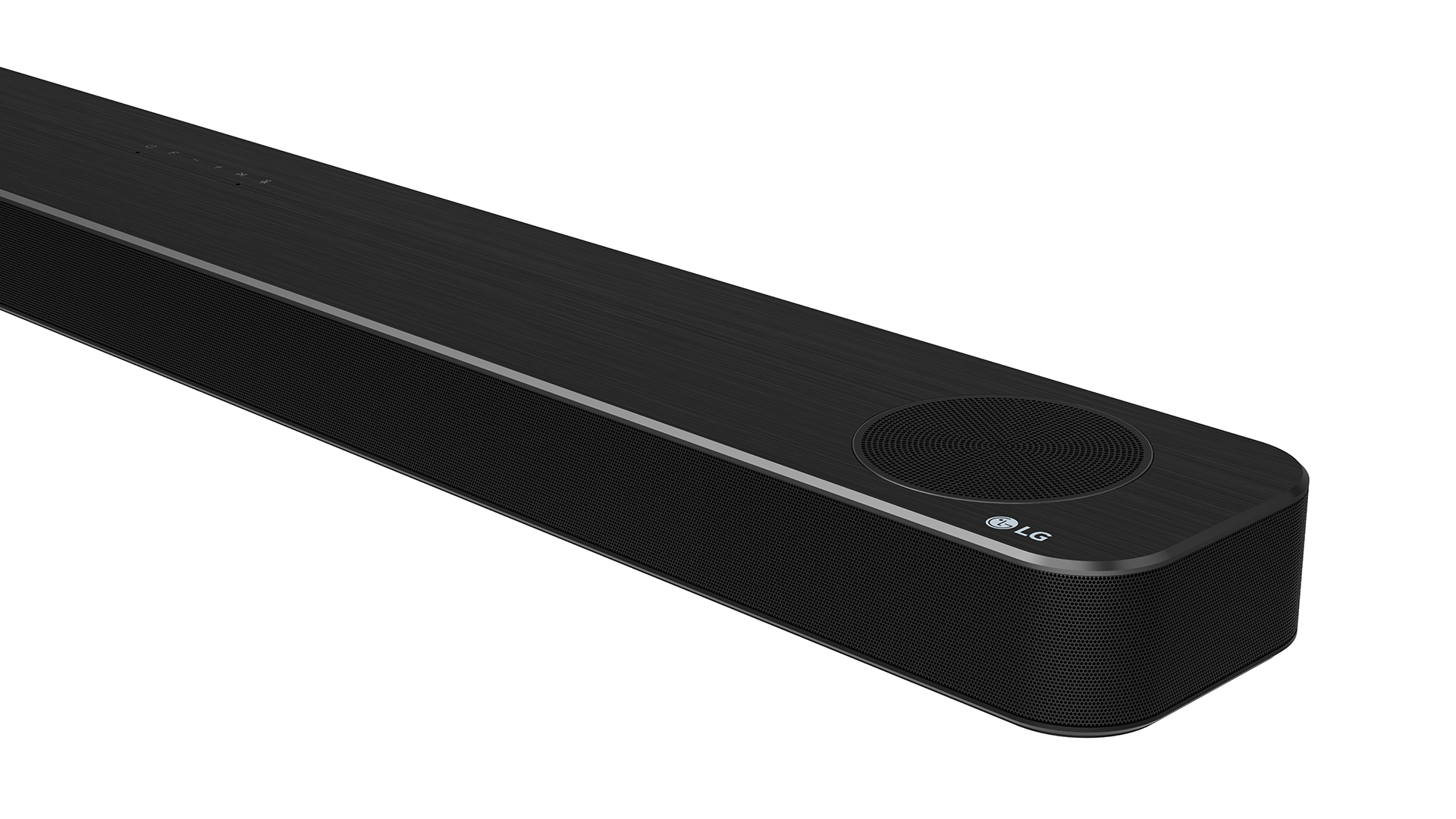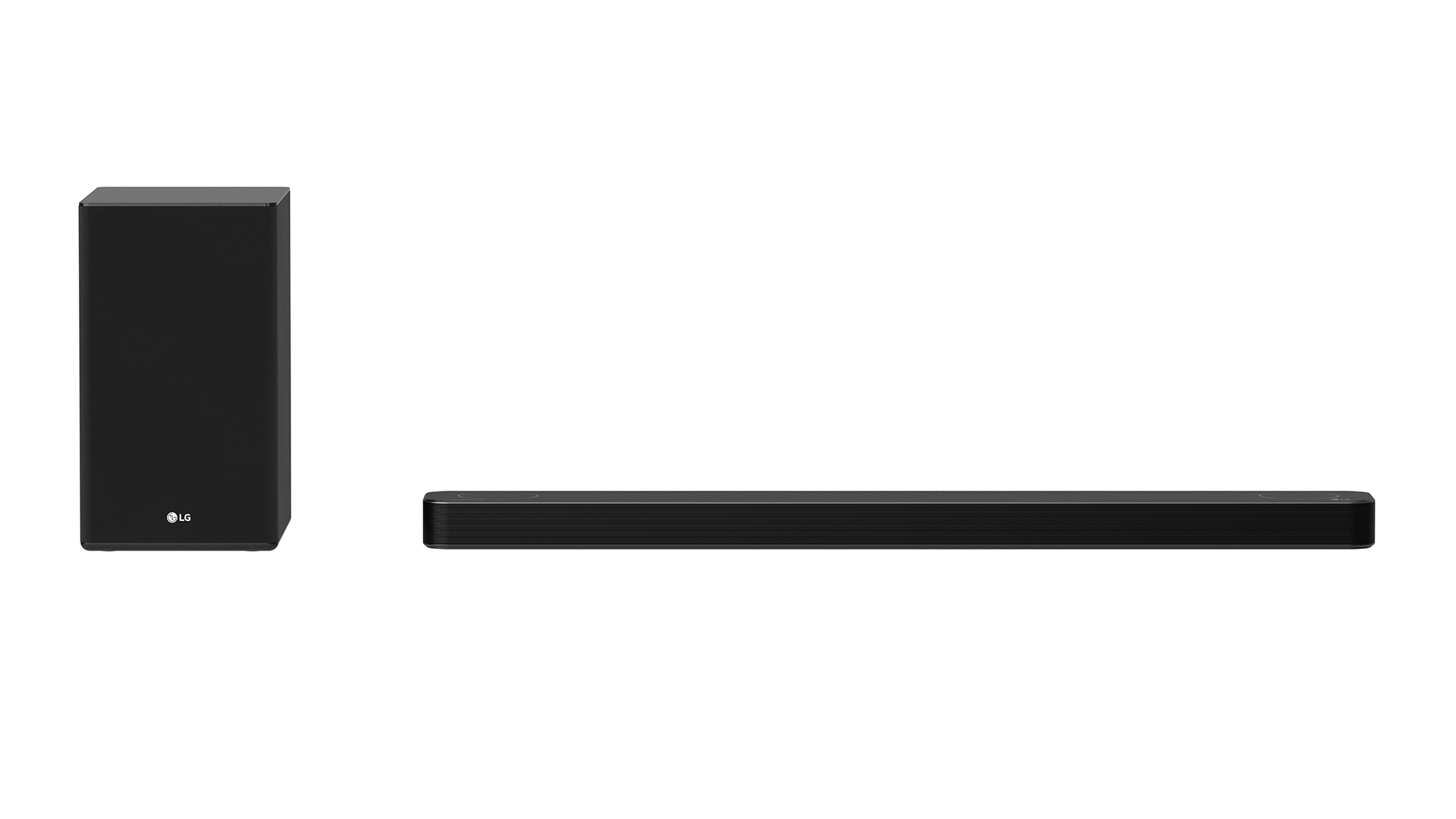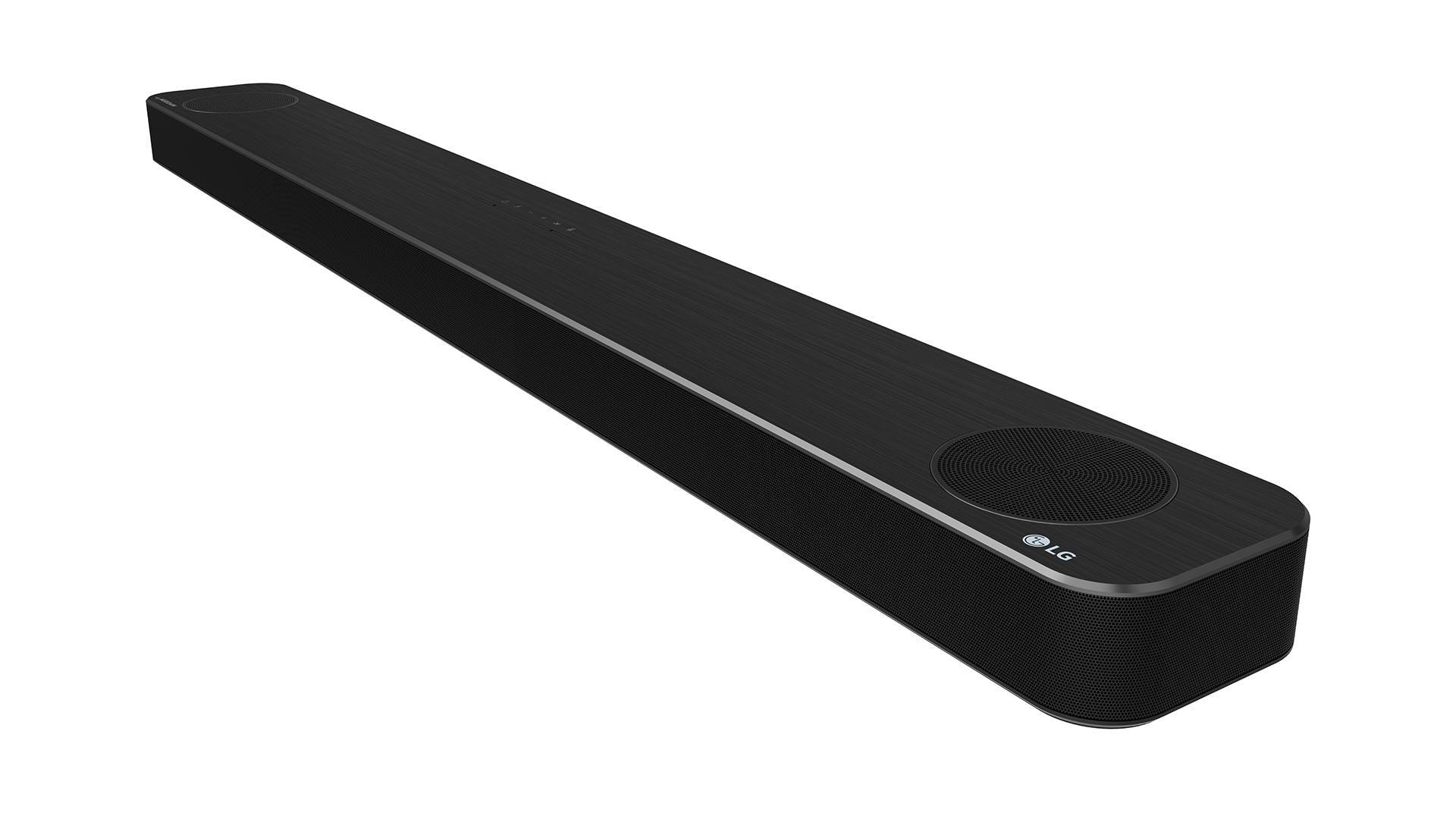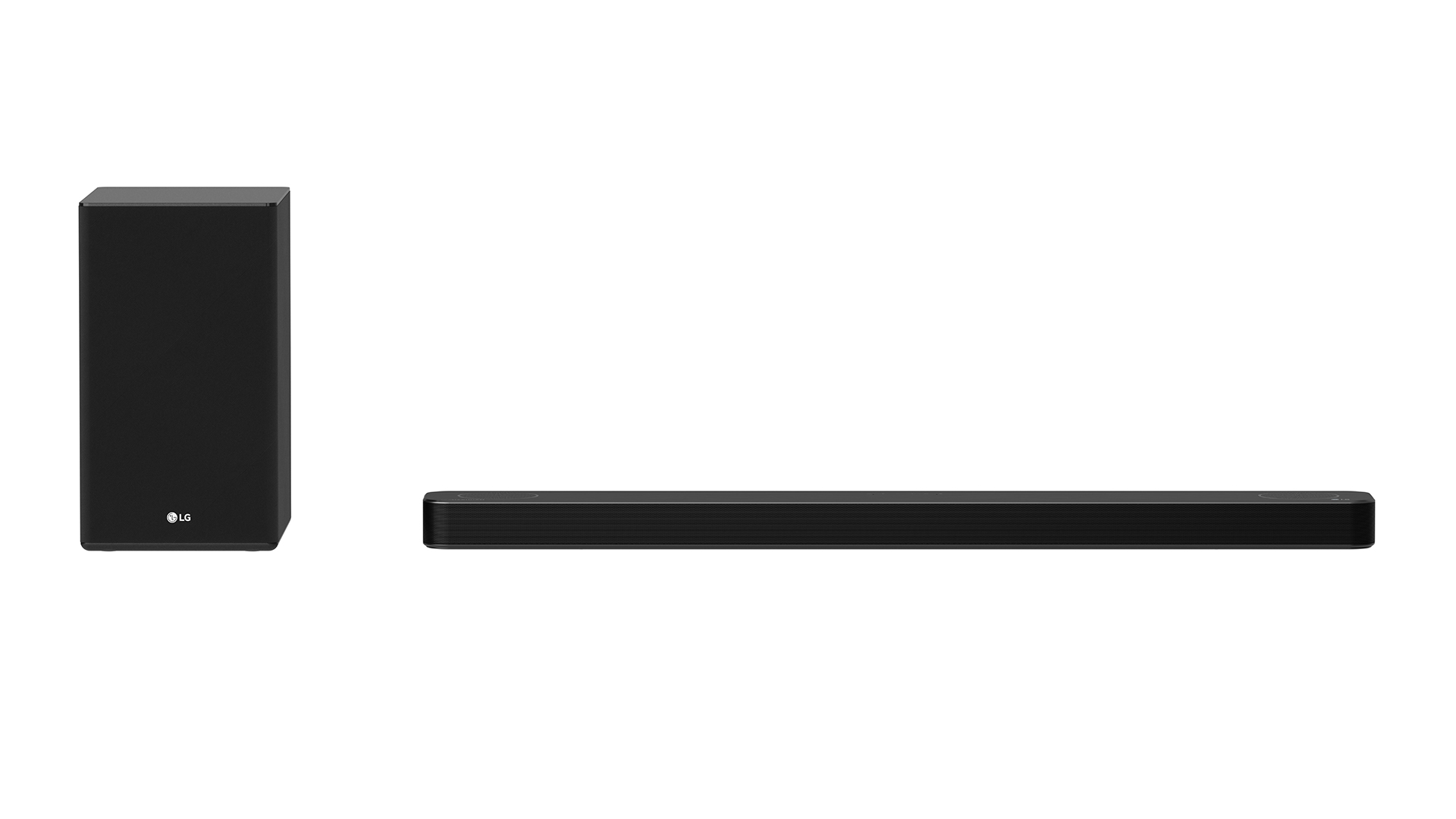What Hi-Fi? Verdict
A forthright and detailed soundbar package that delivers beyond its size
Pros
- +
Extensive feature set
- +
Room-filling soundscape
- +
Easily expanded with surrounds
Cons
- -
Sub lacks definition and impact
- -
Missing some height precision
Why you can trust What Hi-Fi?
When considering which soundbar from within a series would best suit our needs, we usually adhere to the manufacturer’s recommendations for screen-size matching. After all, if you’ve got a decent-sized TV, you want the imaging of the sound to have the same breadth as the visuals.
But LG’s SP8YA proves that just because a soundbar is compact it doesn’t mean that you have to compromise on sonic scope.
Price

The LG SP8YA's price is £600 ($700, AU$934) at launch and brings all of the top tier features and format support of the massive, flagship SP11RA (£1500, AU$1849) down to a bar LG suggests is suitable for a 49-inch screen. It includes the same model of wireless sub as its bigger siblings (the SPP8-W), and the system can be enhanced by adding the SPK8 2.0 surround kit for around £130 ($180, AU$249), meaning you can build a 5.1.2 system for a total outlay of £730 ($880, AU$1183).
It supersedes the SL8YG which, despite offering an in-built Google Assistant, was more modestly priced at £449 ($800 / AU$1099). Upgrades to the new model include additions such as eARC, Apple AirPlay2 and ‘TV Sound Mode Share’ – a feature that follows the latest trend of brand-symbiotic TVs and soundbars, allowing those with a 2021 LG OLED the option of using the TV to handle the soundbar's processing.
Price-wise, the SP8YA is comparable to the five-star Dali Katch One (£649, $1000, $1500), though that 2019 What Hi-Fi Award winner lacks some of the more modern features users now expect.
The nearest rival in terms of channel count and spec is Samsung’s Q700A, a 3.1.2 package with a separate subwoofer that costs £700 ($700, AU$1000). It can be upgraded to a 5.1.4 surround system by adding the SWA-9500S 2.0.2 wireless rear speaker kit, which costs £249 ($248, AU$395) but is currently half price if bought with a 2021 Samsung soundbar.
Alternatively, the Award-winning, Dolby Atmos-enabled Sonos Arc, which costs £799 ($799, AU$1399) on its own, can be expanded through the addition of two One SL speakers (£358, $358, AU$538) and, if required, a Sub (£699, $699, AU$999). This whole system would set you back £1856 ($1856, $2936).
The latest hi-fi, home cinema and tech news, reviews, buying advice and deals, direct to your inbox.
Build

The design of the SP8YA is the same black brushed metallic finish as the more expensive models in the range but with rounded corners, providing a less bulky look. The styling is pretty bland, but at a reasonable 106cm long, it doesn’t have the same imposing feel as the mammoth SP11RA.
The front and sides are wrapped in a tight black metal grille that deceptively indicates drivers on the far ends, but underneath are just the standard left, centre and right channels, each with a 20mm silk dome tweeter and a 10 x 4cm racetrack driver. On the top, under separate circular grilles, are a pair of 6.3cm height speakers.
Also on the top exterior is a mic for room calibration and voice control (the SP8YA is compatible with both Alexa and Google Assistant) as well as touch buttons for power, input, volume, play/pause and quick source select options for wi-fi and Bluetooth 5.0.

Connections eARC, HDMI 2.1, optical, USB
ARC/eARC eARC
Sound format support Dolby Atmos, DTS:X, DTS-HD, PCM
Bluetooth Bluetooth 5
Wi-fi Yes
AirPlay 2 Yes
Chromecast Yes
Voice control Google Assistant, Alexa
Dimensions (hwd) 5.7 x 106 x 12cm (bar); 39 x 22 x 31cm (sub)
Weight: 4.4kg (bar), 7.8kg (sub)
The front face has a five-character swift scrolling LED display for text feedback as you change settings and otherwise constantly shows the active input or indicates when Dolby Atmos content is detected.
At the rear is an HDMI-out port that supports eARC, plus another HDMI 2.1 input with 4K Dolby Vision and HDR10 pass-through. There’s also an optical input and a USB port, the latter for connection to a mass storage device.
The separate wireless sub has a front-facing 18cm bass driver and rear port, wrapped on three sides in a soft black fabric. While it may be ‘wireless’ in terms of audio signal, it still requires power and needs to be located near a plug socket, ideally as close to the main bar as possible – though, as ever, when it comes to bass, it’s best to experiment with positioning to find what works best for your space.
Syncing the two units is straightforward though you will need the LG Soundbar app to find and add the main soundbar to the network, with the sub of our sample automatically joining after. If this fails, there is also a button on the back of each unit for manual pairing.
Features

There’s a comprehensive list of connectivity options that can be easily accessed via the touch buttons, minimalist remote or the app. For streaming, alongside Bluetooth and wi-fi, there’s Chromecast and Apple Airplay 2. If you have access to hi-res content, you’ll be pleased to know the soundbar can handle audio of up to 24-bit/192kHz quality.
The levels of each channel can be turned up or down using the remote or the app, and there’s a broad two-band EQ to tweak the high end or low end of the front of the main unit.
As well as a decent ‘Standard’ sound mode, there are a host of other sound profiles, some of which are new for this year, including a ‘Music’ mode that benefits from tuning courtesy of British audio specialist Meridian, with whom LG has collaborated to enhance its audio products since 2018.
The SP8YA also features ‘Meridian Horizon’, an upmixing technology that LG says will produce immersive multichannel audio from two-channel stereo content.
Upmixing is accessed from the ‘Cinema Sound’ mode, which will output full-range audio from both the front and height channels regardless of the original sound format. The ‘Bass Blast’ profile operates similarly but with added low end. There’s also a ‘Clear Voice’ option and modes optimised for ‘Sport’ and ‘Gaming’. If you’d rather let the soundbar decide, then ‘AI Sound’ mode automatically switches between profiles. There’s an added ‘Night-time’ mode on the LG Soundbar app that compresses dynamics and reduces bass and can only be accessed manually.
If you have a 2021 LG OLED and decide to use ‘TV Sound Mode Share', you gain access to a whole extra set of sound options from your TV's menu. However, it’s worth noting that when watching Dolby Atmos content, all other sound modes are locked out as this uses its own algorithm.
Sound

We start by watching Uncut Gems in Dolby Atmos with its notoriously abrasive and complicated audio mix. The heavily scored opening scene that segues from an Ethiopean gem mine to a colonoscopy has a cinematic reach beyond the SP8YA’s size, easily filling the room (and matching a larger screen). At the same time, the heavy, liturgical synths feel well spaced and tonally vibrant.
As the scene begins, the music doesn’t dip for the dialogue, spoken with chaotic, overlapping naturalism. On a lesser system, and particularly via a TV's in-built speakers, this would be nearly impossible to follow, but the SP8YA effortlessly projects the voices forward. Instead of feeling overwhelmed, we are quickly drawn into the world of The Diamond District.
Switching over to animated post-apocalyptic heart warmer The Mitchells Vs The Machines, we skip to the ‘Mall of the Globe’ battle. There’s nice speed and a coherence to the explosions and transients in this action-packed sequence that we found lacking in its bigger sibling, the SP11RA. The separate sub adds scale to some of the supersized evil appliances, though it is a little undefined.
The SP8YA makes a fair attempt at the varied height elements here, such as overhead killer drones and raining Furbies. While it adds some excitement and movement compared to a non-Atmos bar such as the Dali Katch One, it’s not as precise as the class-leading Sonos Arc, which can extend its reach further toward the viewer.
You can compensate for this somewhat on the LG by adjusting the level of the top speakers in the ‘settings by speakers’ menu by up to +6dB. While this does give a bit more authority to height effects, depending on the film’s mix, you can quickly start to find that the dialogue gets masked, lost, or that scenes sound overly reverberant.
Streaming Season of the Witch by Donovan from Tidal, there’s a terrific crunch to the guitar, and the bass line feels melodic and sprightly. As the psychedelic instrumental break drifts between dreamy and frenzied, there’s a slight loss of timing precision, but the rhythmic texture of the intermingled organ and guitar is detailed and has some nice dynamic subtlety.
While we usually recommend sticking to ‘Standard’ sound modes, the ‘Music’ mode is worth trying here as it blooms the soundstage while also enhancing the bass and treble without sounding synthetic. Listening to the same track on the Dali Katch One, there’s more openness and range to the vocal and mids, but predictably it doesn’t even attempt to go near any of the lower frequencies that the SP8YA does.
Switching to Steely Dan’s sonically precise but lyrically questionable Cousin Dupree, the split between the high and low end on the SP8YA feels a bit more pronounced. The sparkling clarity of the hi-hat and the leading edge of the guitar feels unbalanced by the slightly limp sub on what should be a tight funk bass line. However, it doesn’t manage to pull focus, and smaller embellishments such as the syncopated keyboard line and vocal harmonies still sing out.
Verdict
Although it has fewer channels and less power than its flagship sibling, the SP8YA doesn’t feel like a massive step down sonically. The soundstage still feels expansive, and there’s actually more focus and punch to action scenes, while the option to add the rear surrounds could be an easy and relatively inexpensive way to improve its immersive abilities.
It’s not perfect though. There are better Dolby Atmos performers available for not much more outlay, such as the Sonos Arc, and the separate sub feels like a bit of a missed opportunity, especially considering rival Samsung’s punchy Q range.
But for those looking for a reasonably priced Dolby Atmos soundbar with a high tech spec and a detailed, room-filling sound, the SP8YA is worth considering.
SCORES
- Sound 4
- Features 5
- Build 4
MORE:
Read our round-up of the Best Soundbars 2021
Read our Sonos Arc review
Read our Dali Katch One review
Read our Samsung HW-Q800A review
What Hi-Fi?, founded in 1976, is the world's leading independent guide to buying and owning hi-fi and home entertainment products. Our comprehensive tests help you buy the very best for your money, with our advice sections giving you step-by-step information on how to get even more from your music and movies. Everything is tested by our dedicated team of in-house reviewers in our custom-built test rooms in London, Reading and Bath. Our coveted five-star rating and Awards are recognised all over the world as the ultimate seal of approval, so you can buy with absolute confidence.


